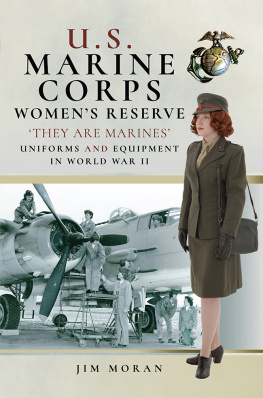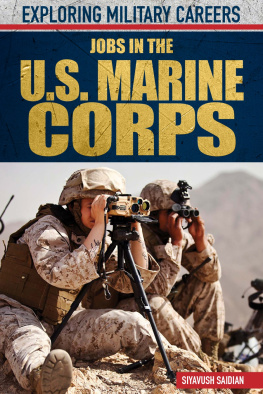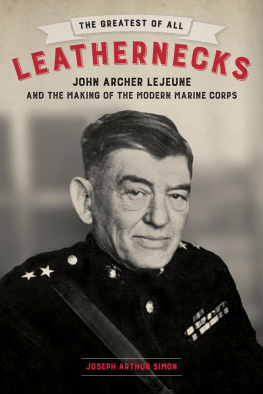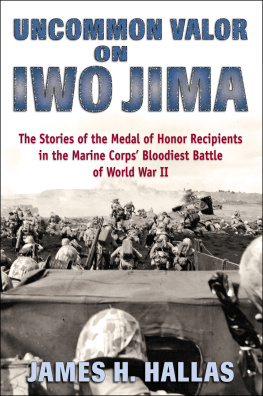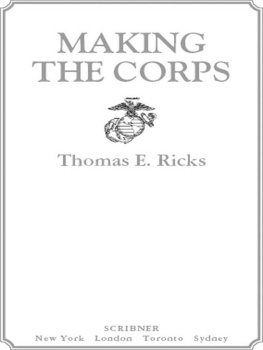
More praise for
THE FEW AND THE PROUD
Marine D.I.s have an awesome responsibility: that of transforming an unorganized, unmotivated, sloppy, unfit civilian into a hard chargn, low crawln, highly disciplined, hard as nails United States Marine. Larry Smiths interviews reveal how this is accomplished. The drive, determination, devotion to duty and professionalism of D.I.s ensure our Corps of Marines remains the best of the best, a true Band of Brothers.
H. C. Barney Barnum Jr.,
Colonel of Marines (Ret.), Medal of Honor Recipient
Distinguished author Larry Smith turns his reporters eye to the worlds most renowned training facility, the place where they make Marines, to write one of the most engaging nonfiction books youll ever read. Rarely will a reader find truth, detail, and action woven together so skillfully, so compellingly. Smith is a true storyteller. Parris Island comes alive in the energizing words of those whove lived it: you smell the air, taste the salt, feel the sand.
Walter Anderson
Smith captures the men and women who are the essence of the Marine Corps.
The Pilot, North Carolina
A multifaceted, personal history of the Marine Corps.
Publishers Weekly
Smiths collection of interviews illuminates one of the U.S. Marine Corps institutional legends, the DI.
Booklist
A superb job of describing how the Corps creates a brand of warrior whose very mention puts the fear of God into their enemies... firsthand accounts from Marine drill sergeants, whose tales include everything from training recruits to the hell of combat.
Military Book Club, as quoted in San Diego Reader
Culminating in the experiences of 28 Marines from Parris Island to MCRCD San Diego, The Few and the Proud brings to life the motivations drill instructors use to push themselves, and their recruits, to the limits, giving them some of the toughest training and richest traditions in the military.
Corporal Brian Kester, The Boot
Together, their accounts contribute to a better understanding of the DI experience, ethos and methods.
Thomas R. Kailbourn, Military Trader
ALSO BY LARRY SMITH
Beyond Glory The Original

From the sands of Iwo Jima to the deserts of Iraq
THE FEW AND THE PROUD
Marine Corps Drill Instructors in Their Own Words
LARRY SMITH

W. W. NORTON & COMPANY
New York London
Copyright 2006 by Larry Smith
All rights reserved
First published as a Norton paperback 2007
For information about permission to reproduce selections from this book, write to Permissions, W. W. Norton & Company, Inc., 500 Fifth Avenue, New York, NY 10110
Book design by Charlotte Staub
Production manager: Anna Oler
Library of Congress Cataloging-in-Publication Data
Smith, Larry, 1940
The few and the proud : Marine Corps drill instructors in their own words / Larry Smith.
p. cm.
ISBN-13: 978-0-393-06044-7 (hardcover)
ISBN-10: 0-393-06044-6 (hardcover)
1. United States. Marine CorpsNon-commissioned officersInterviews. 2. Basic training (Military education)United States. 3. United States. Marine CorpsMilitary life. I. Title.
VE24.S58 2006 |
359.9'650973dc22 | 2006001108 |
ISBN 978-0-393-32992-6 pbk.
ISBN 978-0-393-24323-9 (e-book)
W. W. Norton & Company, Inc. 500 Fifth Avenue, New York, N.Y. 10110
www.wwnorton.com
W. W. Norton & Company Ltd. Castle House, 75/76 Wells Street, London W1T 3QT
FOR S/SGT. EDDIE ADAMS
19332004 Semper Fi, Mac
Come on, you sons of bitchesdo you want to live forever?
attributed to Gunnery Sergeant Daniel Daly, USMC, Belleau Wood, June 1918. Two-time recipient, Medal of Honor
A ny flaws found in this book are, as Mark Twain might have said, the exclusive property of the author. All the good parts were built on strong contributions of several individuals, notably Major Kenneth White (USMC Ret.), who was in charge of public affairs at the Marine Corps Recruit Depot at Parris Island from August 2002 until he retired in early 2006. He was endlessly patient with an ignorant civilian, made splendid suggestions, and dug up phone numbers and facts that greatly enhanced the enterprise. The book itself grew out of a suggestion by Walter Anderson, the chairman and CEO of Parade magazine, who was designated in November of 2005 as a Marine for Life. I cannot thank him sufficiently for all he has done. I also want to thank Lee Kravitz for expert guidance. Col. Mike Malachowsky, chief of staff at Parris Island prior to joining the United States Special Operations Command in Tampa in September of 2004, was kind enough to read parts of the manuscript and offer perceptive suggestions. He also led me to Robert Mastrion, a distinguished former Marine who suggested some excellent interview subjects. Others I wish to thank are Vic Ditchkoff, president of the Drill Instructors Association, Dr. Stephen Wise, director of the museum at Parris Island, and Lt. Anthony Delsignore, deputy director of public affairs at the Marine Corps Recruit Depot in San Diego. Book titles may seem obvious once they are in place but this is not always so. That was the case with this book, and its fine title ultimately came from my wife, Dorothea. I also thank Carole Smith Strasser in El Cajon, California, Jean Fujisaki and Robert Nelson in La Jolla, Cpl. Brian Kester of MCRD Parris Island, the incomparable researcher Lou Leventhal, the technical wizard Jonathan Au, Miriam Lorentzen, and Ponchitta Pierce. Finally, Tom Mayer of Norton was endlessly courteous, patient, and, best, extremely competent. Thank you all.
PARRIS ISLAND AND SAN DIEGO
Where the Marine Corps Begins
The Continental ship Providence, now lying at Boston, is bound on a short cruise, immediately; a few good men are wanted to make up her complement.
Marine Captain William Jones,
Providence Gazette, March 20, 1779
C ertain place names in the United States, such as Gettysburg, West Point, and the Little Bighorn, evoke immediate recognition. Parris Island, the Marine Corps boot camp on the South Carolina coast, is one of these. It is four miles long, three miles wide, and known as a hard place, made special by sand fleas, stultifying heat, and six hundred fearsome, sometimes terrifying, drill instructors. Nearly everyone who joins the Marine Corps from east of the Mississippi undergoes basic training at Parris Island. Those who join from west of the Mississippi are sent to the Marine Corps Recruit Depot (MCRD) in San Diego. No one ever forgets basic training in the Marine Corps. More than two million young men and women have survived training at the two bases, and few, if any, were unaffected by the experience. Marine Corps recruiters maintain, The change is forever. They rarely get an argument.
This book is about the experience of training recruits in the Marine Corps, as seen for the most part by its drill instructors, both active and retired. Men who underwent training as Marines have fought in every American conflict since the Revolution. The D.I.s interviewed for this book helped to train the toughest element of one of the worlds dominant armed forces. As the following chapters will show, any history of Parris Island, San Diego, and their drill instructors is also a history of the Marine Corps itself and, to some extent, of the United States.
Next page


